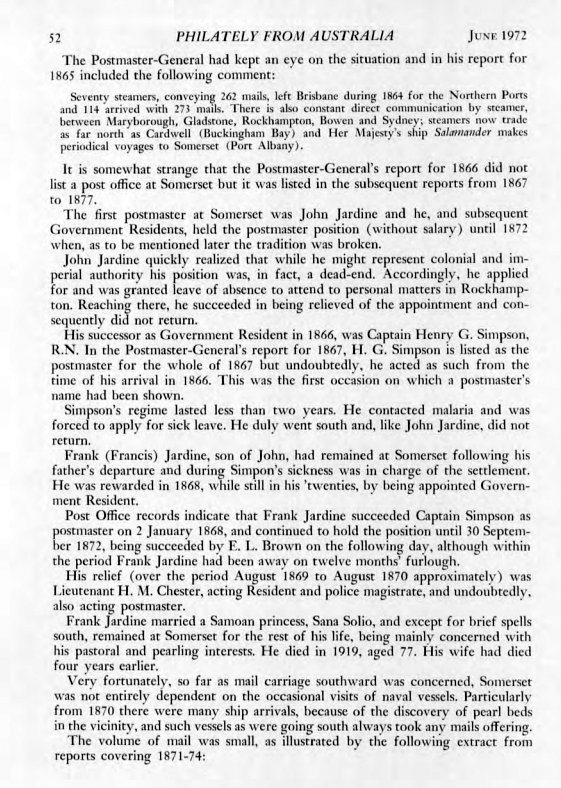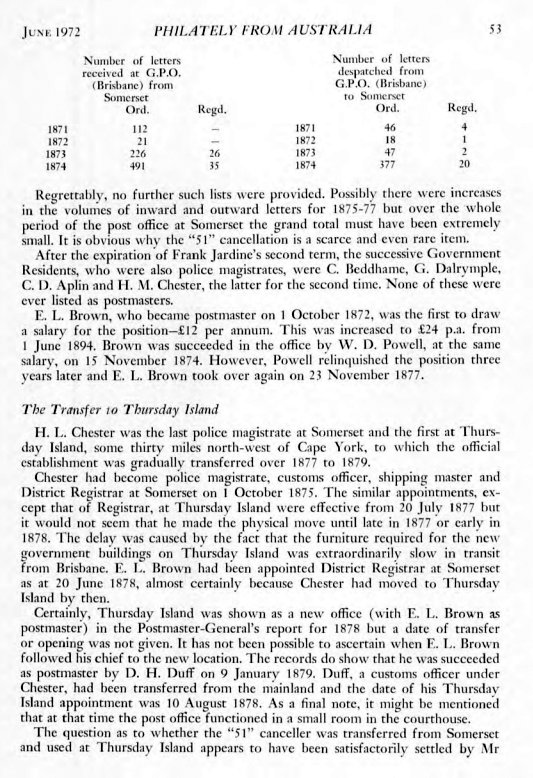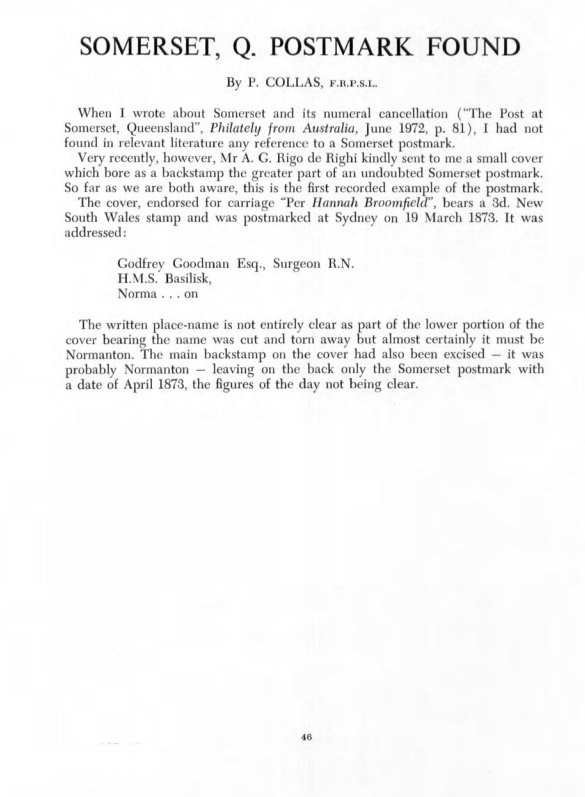By P. COLLAS
Somerset was officially founded on 21 August 1864, with John
Jardine earlier police magistrate and gold commissioner at Rockhampton in
charge with the title of Government Resident.
Settlement had actually commenced on 25 March 1863, when
Jardine first put foot ashore, being accompanied by Dr J. T. Haran as medical
officer and Lieutenant Pascoe with twenty-five marines. The formal founding,
seventeen months later, followed the arrival of H.M.S. Salamander from Sydney
with stores and a few more men.
Somerset, about seven miles south of Cape York, was also
occasionally known as the Port Albany settlement, the name being derived from
Albany Island some miles to sea.
Under its secondary name, Somerset gained brief reference in
the Queensland Postmaster-General's report for 1864:
I have little doubt that
ultimately there will be communication between the Australian Colonies on the
eastern coast, and the mother country, via Torres Straits: On the opening of
Rockingham Bay (which will form an outlet for the produce of a large squatting
company) to which place there must before long be regular steam communication;
thence, as settlements are formed, the trade gradually tending northward, until
it reaches the Port Albany settlement, at the extreme north of the continent of
New Holland. The only distance then to complete the link, will be from Albany
to Timor, at which place the chain from Point de Galle via Singapore will be
complete.
According to some references seen, the post office at
Somerset was opened in 1865. It was certainly listed in the
Postmaster-General's report for that year. This report mentioned incidentally
that the number of country post offices in Queensland then totalled forty-six.
Captain H. S. Porter in Queensland Numeral Cancellations has indicated the
opening period broadly as "1862/64". Undoubtedly, mail was
transmitted, as opportunity occurred, from the time of the initial landing in
1863 and it would be reasonable to assume an opening date in 1863 for the post
office, even though it may have operated only on a skeleton basis at that time.
One would dearly like to know when it was first provided with its
"51" canceller.
At the outset, with H.M.S. Salamander as the normal link, it
was intended that the settlement be visited every four months, the naval vessel
bringing supplies and mails. However, as contemporary records indicate, the
visits were frequently delayed and sometimes six months elapsed before
long-awaited stores arrived.
The same vexatious delays occurred in later years when the
Salamander had been replaced by H.M.S. Freak and, later again, by H.M.S.
Virago. The settlement was for many years a military outpost, and
responsibility for its maintenance fell upon service authorities.
The Postmaster-General had kept an eye on the situation and
in his report for 1865 included the following comment:
Seventy steamers, conveying 262
mails, left Brisbane during 1864 for the Northern Ports and 114 arrived with
273 mails. There is also constant direct communication by steamer, between
Maryborough, Gladstone, Rockhampton, Bowen and Sydney, steamers now trade as
far north as Cardwell (Buckingham Bay) and Her Majesty's ship Salamander makes
periodical voyages to Somerset (Port Albany).
It is somewhat strange that the Postmaster-General's report
for 1866 did not list a post office at Somerset but it was listed in the
subsequent reports from 1867 to 1877.
The first postmaster at Somerset was John Jardine and he,
and subsequent Government Residents, held the postmaster position (without
salary) until 1872 when, as to be mentioned later the tradition was broken.
John Jardine quickly realized that while he might represent
colonial and imperial authority his position was, in fact, a dead-end.
Accordingly, he applied for and was granted leave of absence to attend to
personal matters in Rockhampton. Reaching there, he succeeded in being relieved
of the appointment and consequently did not return.
His successor as Government Resident in 1866, was Captain
Henry G. Simpson, R.N. In the Postmaster-General's report for 1867, H. G.
Simpson is listed as the postmaster for the whole of 1867 but undoubtedly, he
acted as such from the time of his arrival in 1866. This was the first occasion
on which a postmaster's name had been shown.
Simpson's regime lasted less than two years. He contacted
malaria and was forced to apply for sick leave. He duly went south and, like
John Jardine, did not return.
Frank (Francis) Jardine, son of John, had remained at
Somerset following his father's departure and during Simpson's sickness was in
charge of the settlement. He was rewarded in 1868, while still in his
'twenties, by being appointed Government Resident.
Post Office records indicate that Frank Jardine succeeded
Captain Simpson as postmaster on 2 January 1868, and continued to hold the
position until 30 September 1872, being succeeded by E. L. Brown on the
following day, although within the period Frank Jardine had been away on twelve
months' furlough.
His relief (over the period August 1869 to August 1870
approximately) was Lieutenant H. M. Chester, acting Resident and police
magistrate, and undoubtedly. also acting postmaster.
Frank Jardine married a Samoan princess, Sana Solio, and
except for brief spells south, remained at Somerset for the rest of his life,
being mainly concerned with his pastoral and pearling interests. He died in
1919, aged 77. His wife had died four years earlier.
Very fortunately, so far as mail carriage southward was
concerned, Somerset was not entirely dependent on the occasional visits of
naval vessels. Particularly from 1870 there were many ship arrivals, because of
the discovery of pearl beds in the vicinity, and such vessels as were going
south always took any mails offering.
The volume of mail was small, as illustrated by the
following extract from reports covering 1871-74
Regrettably, no further such lists were provided. Possibly there were increases in the volumes of inward and outward letters for 1875-77 but over the whole period of the post office at Somerset the grand total must have been extremely small. It is obvious why the "51" cancellation is a scarce and even rare item.
After the expiration of Frank Jardine's second term, the
successive Government Residents, who were also police magistrates, were C.
Beddhame, G. Dalrymple, C. D. Aplin and H. M. Chester, the latter for the
second time. None of these were ever listed as postmasters.
E. L. Brown, who became postmaster on 1 October 1872, was
the first to draw a salary for the position-£12 per annum. This was increased
to £24 p.a. from 1 June 1894. Brown was succeeded in the office by W. D.
Powell, at the same salary, on 15 November 1874. However, Powell relinquished
the position three years later and E. L. Brown took over again on 23 November
1877.
The Transfer to Thursday Island
H. L. Chester was the last police magistrate at Somerset and
the first at Thurs-day Island, some thirty miles north-west of Cape York, to
which the official establishment was gradually transferred over 1877 to 1879.
Chester had become police magistrate, customs officer,
shipping master and District Registrar at Somerset on 1 October 1875. The
similar appointments, except that of Registrar, at Thursday Island were
effective from 20 July 1877 but it would not seem that he made the physical
move until late in 1877 or early in 1878. The delay was caused by the fact that
the furniture required for the new government buildings on Thursday Island was
extraordinarily slow in transit from Brisbane. E. L. Brown had been appointed
District Registrar at Somerset as at 20 June 1878, almost certainly because
Chester had moved to Thursday Island by then.
Certainly, Thursday Island was shown as a new office (with
E. L. Brown as postmaster) in the Postmaster-General's report for 1878 but a
date of transfer or opening was not given. It has not been possible to
ascertain when E. L. Brown. followed his chief to the new location. The records
do show that he was succeeded as postmaster by D. H. Duff on 9 January 1879.
Duff, a customs officer under Chester, had been transferred from the mainland
and the date of his Thursday Island appointment was 10 August 1878. As a final
note, it might be mentioned that at that time the post office functioned in a
small room in the courthouse.
The question as to whether the "51" canceller was
transferred from Somerset and used at Thursday Island appears to have been
satisfactorily settled by Mr A. G. Rigo de Righi. ("Thursday Island'', by
A. G. Rigo de Righi. Philatelic Magazine, 24 November 1967.) The cover which he
mentioned as proving the point has an 1881 date and is almost certainly the
same cover as listed by Charles Jewell in an article in The Philatelist some
years ago. It would appear to be the only evidencing cover known. Impressions
of the "51" canceller are hard to come by and while I am fortunate in
possessing a strike on S. G. 100, this is quite inconclusive as to place of
usage.
This item was listed in Abacus auction no 250 lot no 906 showing a Cape York (Somerset) manuscript annotation. The auction text is "1872 (Dec 26; Boxing Day) overweight officer's letter to "F O'Neill Esquire/HMS Basilisk/Sydney NSW/Australia/Or Elsewhere", endorsed "Via Brindisi" with Great Britain 9d straw Plate '4' tied by 'DEVONPORT/FE20/73 - 250' duplex, British 'DEFICIENT POSTAGE ("9")/FINE ("6")' h/s & rated "1/3" in black, 'SYDNEY/ C /FE21/73 = A =' transit b/s, endorsed on the face "Recd/at/Cape York/15 May/1873" by the recipient"












No comments:
Post a Comment